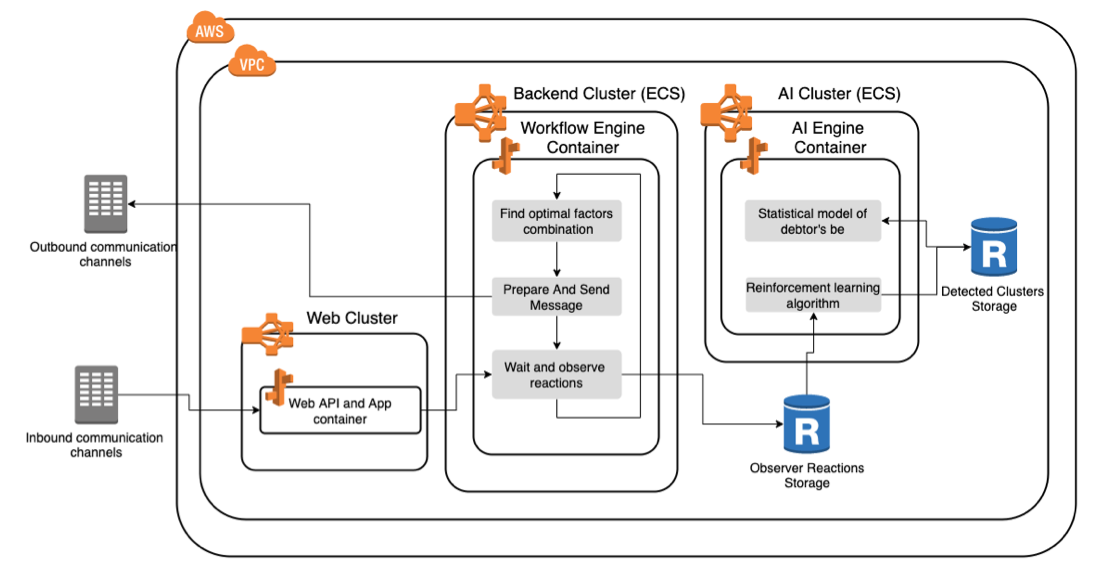AWS Startups Blog
Rethink Debt Collection: How Machine Learning Improves your Receivables Management

Guest post by Denise Schoenherr, Senior Manager Corporate Communications and Dmitry Sharkov, CTO, PAIR Finance GMBH
No one wants to hear from a debt collection agency. Most people associate it with letters in red, capital characters, high charges with imaginative reasons and intrusive phone calls. Berlin-based fintech PAIR Finance’s mission is to change that with the help of Machine Learning, introducing you and your customers to a completely new debt collection experience.
In a technology driven world, effectively gathering and acting on data-driven decisions is essential for success. With Machine Learning (ML), Amazon Prime Video is able to automatically curate precise recommendations for viewers and Gmail can accurately filter and categorize incoming emails. Developments in ML are also having a great impact on the receivables industry. Welcome to a new approach in debt collection. PAIR Finance has created a unique collection technology for the shifting preferences of modern consumers, enabling businesses in Germany and beyond to recover lost revenue from unpaid claims faster and more customer oriented.
“The future of debt collection is digital, but the collection industry is not digitized at all,” explains CEO and founder Stephan Stricker. “Traditional collection strategies are less effective, because they don’t address the continuing changes in consumer behavior. Since mid-2016, we have been dealing with outstanding receivables from companies that attach importance to digital and efficient processes and do not want to reduce their customer base by coercion, but rather retain and expand them through respectful handling.”
One company is Europe’s biggest online fashion retailer Zalando. It partners with PAIR Finance to resolve customer issues and retain lost relationships. The vast majority of the outstanding receivables that are collected, are recovered by PAIR Finance with shockingly positive reviews: 85 percent of the customers say, that they are happy with PAIR Finance’s service. Some more of the 250 corporate clients of the fintech startup include major industry leaders like Klarna, Grover, Sixt and Mydays but also small and mid-sized companies. They all rely on the ML-driven platform that uses an algorithm to decide how the debtor is asked to pay, learns best practices from implementations and continuously improves over time.
Marketing meets debt collection
How does it work? Before PAIR Finance gets in touch with a consumer, a digital search of the person starts, based on the personal data provided by the commissioning company within the legal framework. Data from credit agencies, credit institutions and market data help to obtain a better idea about the solvency of the consumer. Digital data obtained from cookie and link tracking or the e-mail authentication process provides additional information about the socioeconomic status. Through this step, data points are collected, through which the consumer is automatically typologized. A little creepy? Maybe, but with a good payoff. Originally, this data-driven use of Machine Learning is found in digital marketing, “programmatic advertising,” with the aim of encouraging consumers to buy. PAIR Finance bridges the gap between marketing and receivables management and applies a similar technological approach.
Leverage Machine Learning infused with behavioral science
Furthermore, behavioral psychology is an important component of success. Each customer behaves individually when confronted with an outstanding debt. This can range from rejection, to fear, to quick settlement. For example, is the customer someone who compares himself to other social groups and wants to be part of them? Then we resort to an e-mail containing a social comparison, such as “Nine out of ten customers in Germany pay their bill on time. Take your chance to pay now and don’t waste any more time”. Or is it someone who needs a profit incentive to respond? Then the jackpot effect comes into play, where an attractive offer, such as waiving a fee or offering a settlement, suggests to the customer that he will also make a profit by paying back the debt. PAIR Finance can contact the consumer in over 30,000 different ways, leveraging different parameters:
- Channel: multidimensional contact strategies via 7 digital and analogue media to achieve optimum customer accessibility.
- Timing: the optimum time to reach your customer depending on how their everyday life is being structured.
- Possible solutions: the algorithm takes the financial situation of the consumer into account and adapts the offer of possible individual solutions via our intelligent payment page.
- Frequency: the right sequence of contact points over time can reduce stress or deliberately build up pressure on your customer.
- Tonality: different formulations have an impact on the inner attitude of your customer and set the scene to be addressed directly.
- Stylistic tools: both, the style of the language and graphical elements are stylistic tools which help your customers understand the content.
A dedicated ML Framework hosted on Amazon ECS
To find the combination of these 6 factors for every debtor we use a family of applied statistical methods gathered under the umbrella name of “Reinforcement Learning”. In simple words they could be described like “if something works better then try it more often”. In our system we have a so-called “workflow engine” which technically is a containerized application hosted on Amazon ECS (Elastic Container Service). Because of incredible scalability provided by ECS, we can run hundreds of thousands of workflows simultaneously.
Every workflow is a chain of communication points (or steps). And every communication point is a composition of 6 factors described below. So, in order to make a next step the engine has to make a decision about:
- What to offer
- Which argument to use
- What kind of totality to use
- What channel to use for the message
- When to sent the message
- How long to wait until next message should be sent
To make these decisions, workflow engines make a request AI-engine, which is an intellectual core of our system. Technically it’s also a containerized application written in Python and C. It’s using some standard libraries, but most of its code is custom development inside our team. The AI-engine is responsible for observing debtors reactions on our messages, defying groups (or clusters) of debtors for which some combinations of factors seem to work better and making decisions for new communication steps based on collected information.
The technical challenge we faced while building our AI-engine high computational capacity requirements of modern statistical methods and reinforcement learning algorithms in particular. And the scalability of AWS services helps us here as well.

An effortless repayment experience and increase in cash flow
With the help of ML PAIR Finance drives smart dialogue between businesses and customers. This is, where paying comes in: Via e-mail, SMS or WhatsApp, PAIR Finance can not only deliver outstanding receivables faster than by post, but also demonstrably reaches the recipient exactly where he or she checks several times a day anyway: on his or her smartphone or PC. The consumer can also pay the outstanding debt completely online with just a few fingertips via a direct link to an intelligent payment page. Here, the invoice can be paid by instant bank transfer, Credit Card, direct debit, cash, Apple Pay or with the electronic reseller Clevertronic. For this purpose, PAIR Finance works together with a number of financial service providers. Alternatively, the consumer can quickly and digitally compile and complete his individual installment payment plan and thus complete the collection process quickly and easily online.
Building and continuing to maintain complex systems like these, require a talented team and a stable infrastructure that can support these processes at scale. More than 80 employees, among them three behavioral scientists, help our machine learn to nudge customers to repayment by creating personalized dialogue.
Protecting your business reputation
Since Machine Learning can automate communication, you know that all your customer correspondence will be professional, methodical and unambiguous. PAIR Finance’s collections platform provides its users with a customer-oriented point of engagement, which is proven to be highly successful. Only around 5 to 10 percent of the outstanding receivables, that PAIR Finance manages, have to be sent to court for collection. In addition, PAIR Finance uses the CSAT score (Customer Satisfaction Score) to measure customer satisfaction after the collection process. With an average score of 4 points (scale from 1=low to 5=high), this reflects positive feedback from consumers.
The good rating proves that a ML-based approach, a high degree of user-friendliness and hyperpersonalized solutions are valued by consumers in the collection process. As a result, they have positive memories of the company that commissioned PAIR Finance with its receivables management – and ultimately remain customers.
A fresh opportunity to vastly improve debt recovery rates
Debt collection becomes a focus for many companies that have to change their collections efforts in these uncertain times – from an afterthought to a key leverage able asset to build advocacy and therefore a strategy to maintain cash flow. Machine learning gives its users the opportunity to vastly improve debt recovery rates in an ever changing landscape.